ADVERTISEMENT
Vascular Access-Site Choice and Outcomes in Patients With Previous Coronary Artery Bypass Surgery Undergoing Coronary Catheterization in a High-Volume Transradial Center
Abstract
Background. Transradial access for coronary angiography was observed to be superior to femoral access. Nevertheless, femoral artery access is still frequently used, especially in challenging subgroups with high procedural complexity, like patients with previous coronary artery bypass grafting (CABG). Purpose. We analyzed access-site choice and outcomes of CABG patients undergoing coronary catheterization in different clinical settings. Methods. A total of 1206 consecutive CABG patients undergoing coronary angiography and intervention were included in this study. Procedural and clinical outcomes were compared between transradial and transfemoral access. Multivariate logistic regression analysis was performed to identify predictors of access-site choice. Results. Coronary catheterization was performed via radial access in 753 patients (63.1%) and via femoral access in 442 patients (36.9%). During the study period, femoral artery utilization dropped from 55.2% to a minimum of 28.2% per year (P<.01). Short stature (odds ratio [OR], 1.62; P<.01), peripheral artery disease (OR, 1.42; P=.04), cardiopulmonary resuscitation (CPR) (OR, 4.17; P<.001), ST-segment elevation myocardial infarction (STEMI) (OR, 2.56; P=.01), and coexisting left and right internal mammary artery (LIMA/RIMA) bypass grafts (OR, 2.67; P<.001) were independently associated with femoral access-site choice. Study outcomes including access-site complications (4.3% vs 1.6%; P<.01) as well as short- and long-term mortality (30-day mortality: 6.8% vs 2.0%; hazard ratio, 3.52; 95% confidence interval, 1.84-6.70; P<.001) were more likely to occur with femoral access. Length of stay was shorter in the radial cohort (3.7 ± 5.1 days vs 5.3 ± 7.2 days; P<.001). Conclusion. Radial access appears to be favorable even in complex CABG patients. Although radial access was set as the standard vascular approach, femoral access was chosen in one-third of all patients. Independent predictors for femoral access were short stature, peripheral artery disease, acute settings like CPR and STEMI, as well as coexisting LIMA and RIMA grafts.
J INVASIVE CARDIOL 2022;34(3):E237-E248.
Key words: access choice, access-site crossover, CABG, coronary catheterization, vascular access
Introduction
Nowadays, radial artery access is the preferred vascular approach for percutaneous coronary angiography and intervention in various clinical settings.1,2 This change has been driven by several studies published during the last decade comparing femoral with radial access. These studies showed reductions in access site and bleeding complications, improvement in patient comfort and satisfaction, earlier ambulation and recovery, shorter length of hospital stay, as well as a reduction in mortality across a wide spectrum of patients when using the radial approach.3-6 Nevertheless, in complex case subgroups, ie, patients with a history of coronary artery bypass grafting (CABG), angiography is still frequently performed using femoral artery access.7 Due to usually severe atherosclerosis, complex coronary artery disease (CAD), a wide range of graft configurations, high-risk target lesions, and a propensity for chronic total occlusion (CTO), CABG patients represent a vulnerable and challenging subpopulation with complex and technically demanding coronary procedures.8 Although patients with previous CABG comprise a significant portion of the CAD population, this subgroup was often excluded or under-represented in clinical access site trials,5,9 and therefore limited evident data are available.
The purpose of the present study was to describe baseline demographics, procedural characteristics and predictors, as well as procedural and clinical outcomes of a large CABG cohort undergoing coronary catheterization using femoral or radial access in a high-volume university center having set radial access as the standard vascular approach.
Methods
This retrospective, single-center study included 1206 patients with prior CABG undergoing percutaneous coronary angiography or intervention at our university hospital center between April 2010 and May 2018. We excluded 12 patients (1.0%) with ulnar or brachial artery access from this analysis (6 patients each). The final study population (1194 patients; 99.0%) was divided between patients with either a femoral or radial approach.
Radial access was introduced at our department in 2010 according to guideline recommendations and since then has been our preferred vascular access site. Left ventricular angiography was performed in each case with a 4-Fr pigtail catheter and with 35 mL contrast media for left anterior oblique (LAO) and 15 mL for right anterior oblique (RAO) projection. Standard sheath size for diagnostic cardiac catheterization was 5 Fr while a 6-Fr guide catheter was used for coronary intervention.
Preprocedural parameters, procedural data, and clinical outcomes were evaluated for each patient and compared between the 2 groups. In a subgroup analysis, patients with an access-site crossover (from radial to femoral access) were compared with those who had an initially successful radial approach. All procedures were performed according to contemporary guidelines and all treatment decisions, including choice of vascular access, antithrombotic regime, and type of stent implanted were at the operator's discretion. Patients with access-site crossover were allocated to the site of ultimately performed vascular access. Procedural success was defined as successful completion of the coronary procedure (diagnostic or interventional). The length of clinical follow-up was 1 year. The outcomes of interest were 30-day and 1-year mortality, length of hospital stay, and periprocedural access-site complications. Furthermore, several procedural outcomes, including procedure time, fluoroscopy time and dose, rate of failed PCI, and amount of contrast media used, were assessed. Access-site complications included access-site bleeding as well as vascular complications like large hematoma (>5 cm), arteriovenous fistula, pseudoaneurysm, and retroperitoneal hematoma.
The study was approved by the local ethics committee and has been performed in accordance with the ethical standards set forth by the Declaration of Helsinki.
Statistical analysis. Data are presented as mean ± standard deviation, median with interquartile range (IQR; 25th-75th percentiles), proportions (%), or Kaplan-Meier estimates. The normality of distribution of continuous data was tested with the Kolmogorov-Smirnov test. Non-normally distributed continuous variables were compared with the unpaired U-test. Categorical variables were compared with the chi-square test.
Univariate analysis included all significant and appropriate factors associated with access site choice (P<.10 in unpaired U-test and chi-square test). Pearson’s and Spearman Rho correlation function was used to analyze statistical dependence between the rankings of significant variables of the univariate analysis. Variables with relevant correlation (r>0.4) were not included in the multivariate regression analysis. Multivariate logistic regression analysis (full model) was performed to identify independent predictors of access-site choice and included all significant and appropriate influential variables of univariate analysis (P<.05). A separate multivariate logistic regression analysis was performed to identify independent predictors associated with the risk for access-site crossover. The strength of the association was estimated by calculating the adjusted odds ratio (OR) with the 95% confidence interval (CI).
Time-to-event analyses were performed using Kaplan-Meier estimates and were compared with the log-rank test. Kaplan-Meier curves were generated for time to mortality. The differences in survival rates are described by hazard ratio (HR) with the 95% CI.
To better assess the association between vascular access and the risk of mortality, a multivariate Cox proportional hazard model was performed including the variables femoral approach, ST-segment elevation myocardial infarction (STEMI), and cardiopulmonary resuscitation (CPR).
A P-value of <.05 was considered to indicate statistical significance. All statistical analyses were performed using SPSS, version 25 (IBM Corp).
Results
Baseline characteristics. The present study included 1194 patients with a history of CABG undergoing coronary catheterization (mean age, 72.3 ± 9.4 years; 81.2% males; mean number of bypass grafts, 2.85 ± 1.0). In total, 757 patients (63.7%) presented with left internal mammary artery (LIMA) graft, 14 patients (1.2%) with right internal mammary artery (RIMA) graft, and 86 patients (7.2%) had both LIMA and RIMA grafts. The group undergoing percutaneous coronary intervention (PCI) included 686 patients (57.5%) and there were 508 patients (42.5%) undergoing diagnostic coronary angiography. Native-vessel PCI was performed in 482 patients (70.2%) and bypass graft PCI in 229 patients (33.4%).Based on vascular access site, the entire study population was dichotomized into 441 patients (36.9%) with femoral access and 753 patients (63.1%) with radial access. Within the radial group, the left radial approach was used in 498 patients (66.1% ) and via the right radial artery in 255 patients (33.9%). Of all patients with LIMA graft, 507 (66.9%) underwent coronary catheterization via the radial approach. Of these, the left radial approach was used in 414 patients (81.7%) and the right radial artery was used in 93 patients (18.3%). In patients with RIMA graft, the radial approach was used in 8 patients (57.1%), and 7 of those cases (87.5%) were performed via the right radial artery. Of the 86 patients with both LIMA and RIMA grafts, femoral access was used in 51 (59.3%). Overall, femoral artery utilization fell from 55.2% in 2010 to a minimum of 28.2% in 2016 (P<.01). Since 2012, significantly more coronary catheterizations have been performed annually via radial access compared with femoral access (P<.01).
Table 1, Part 1 and Table 1, Part 2 displays baseline and procedural characteristics comparing the different vascular access sites. Compared with radial access, patients in whom a femoral approach was used were more likely to be female (96 patients [21.8%] vs 129 patients [17.1%]; P=.048), have a smaller body size (168 ± 14.6 cm vs 171.2 ± 10.2 cm; P<.001), lower levels of hemoglobin before procedure (12.1 ± 2.2 g/dL vs 12.3 ± 2.0 g/dL; P=.01), or suffer from multivessel CAD (extent of CAD, 2.90 ± 0.33 vs 2.84 ± 0.45; P=.048). These patients were also more likely to have comorbidities like diabetes mellitus (191 patients [44.1%] vs 257 patients [34.3%]; P<.001), peripheral artery disease (93 patients [21.2%] vs 115 patients [15.3%]; P=.01), severe kidney injury (39 patients [8.9%] vs 39 patients [5.2%]; P=.01), acute coronary syndrome (ACS) (176 patients [39.9%] vs 247 patients [32.8%]; P=.01), or CPR (20 patients [4.5%] vs 11 patients [1.5%]; P<.01). Furthermore, patients with a LIMA graft were more often treated via the radial approach (507 patients [67.7%] vs 250 patients [56.9%]; P<.001), whereas femoral access was used more frequently in patients with LIMA and RIMA grafts (51 patients [11.6%] vs 35 patients [4.7%]; P<.001).
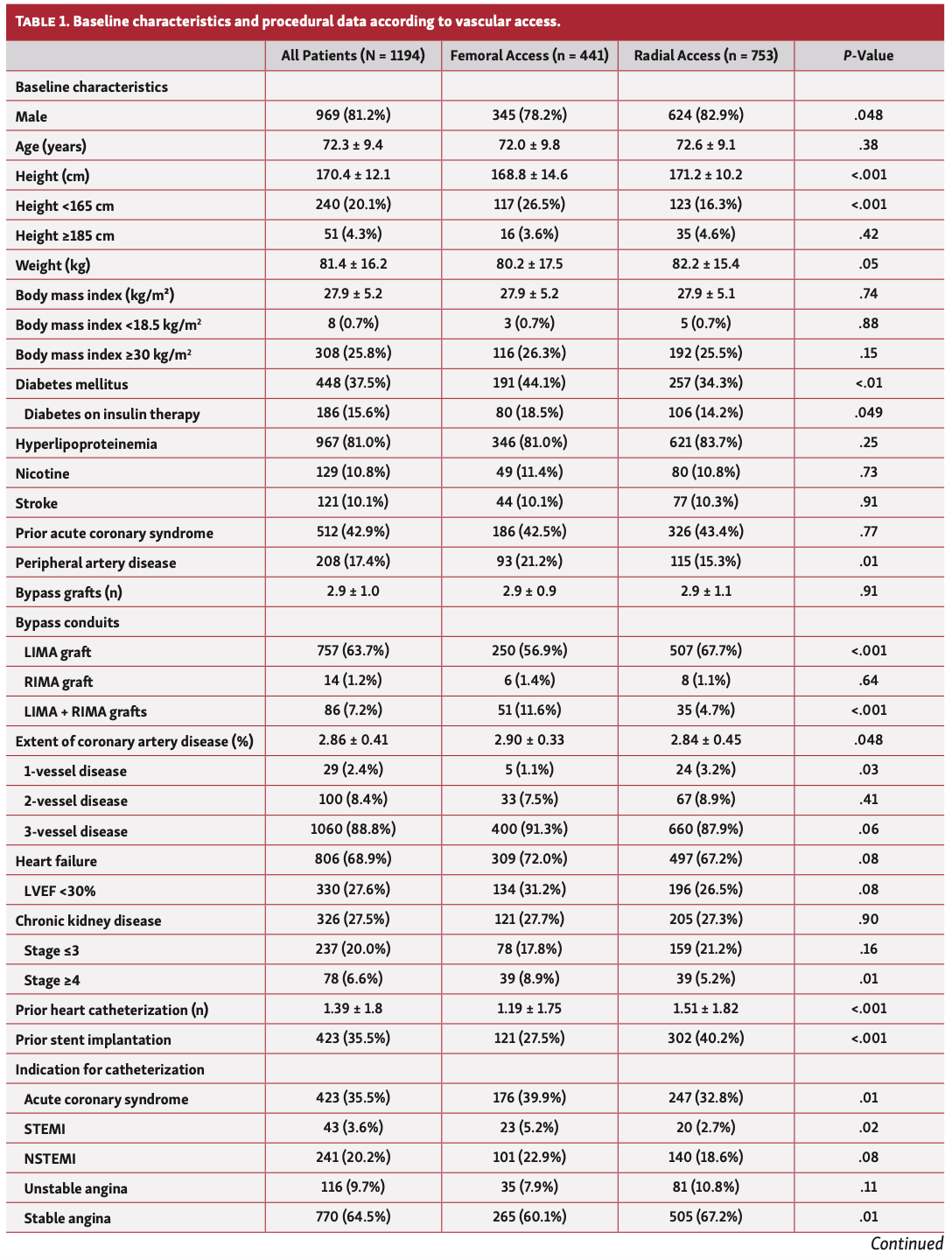
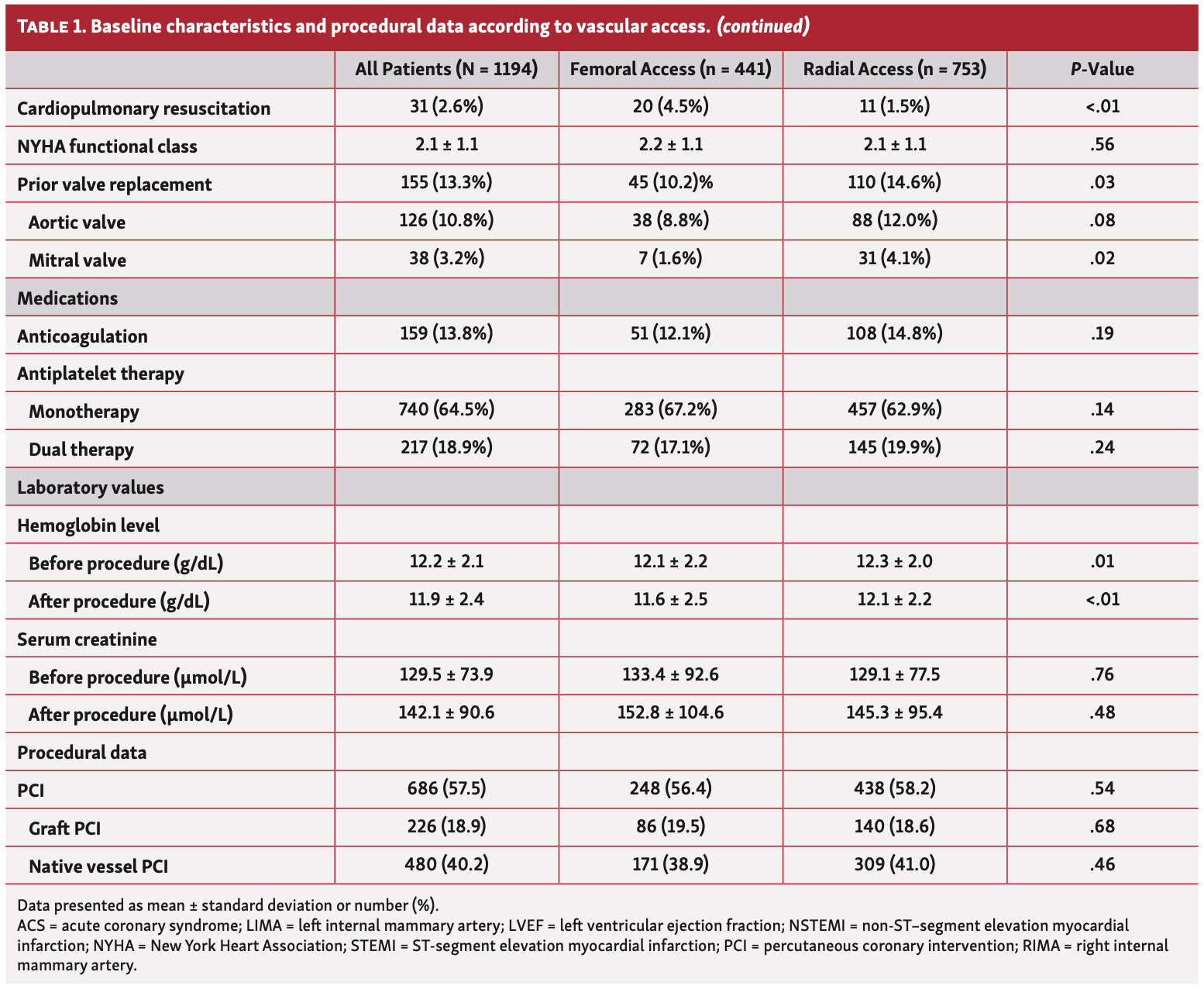
Predictors of access-site choice. Using multivariate logistic regression analysis of all significantly tested variables, covariates associated with access-site choice in patients with previous CABG between 2010 and 2018 were identified (Table 2). Of all variables, small body size (OR, 1.61; P<.01), peripheral artery disease (OR, 1.43; P=.04), STEMI (OR, 2.56; P=.01), and CPR (OR, 4.17; P<.01) were independently associated with femoral access, whereas prior stent implantation was significantly correlated with radial approach (OR, 1.86; P<.001). In addition, LIMA grafts were significantly associated with radial approach (OR, 1.44; P=.01), while coexisting LIMA and RIMA grafts were related to the use of a femoral access site (OR, 2.67; P<.001). A separate analysis revealed that undergoing cardiac catheterization from year 2012 onward was an independent predictor for radial access (OR, 1.71; P<.001).

Procedural and clinical outcomes. Femoral access was associated with a significantly longer procedural time (88.5 ± 1.9 minutes vs 72.8 ± 1.2 minutes; P<.001) and fluoroscopy time (1481.4 ± 52.2 seconds vs 1301.2 ± 31.8 seconds; P<.01) as well as with a higher volume of contrast given (210.5 ± 5.0 mL vs 196.8 ± 3.7 mL; P=.01) when compared with the radial access. Furthermore, the procedural failure rate was significantly higher in patients treated via the femoral artery (17 patients [3.9%] vs 14 patients [1.9%]; P=.04).
Relevant access-site complications (19 patients [4.3%] vs 12 patients [1.9%]; P<.01) were more likely to occur with femoral access compared with the radial approach. A drop in hemoglobin level (-0.48 ± 1.47 g/dL vs -0.24 ± 1.38 g/dL; P<.01) was also significantly higher after coronary catheterization via the femoral access route.
Consequently, the postprocedural length of hospital stay was shorter in the radial cohort compared with the femoral cohort (3.7 ± 5.1 days vs 5.3 ± 7.2 days; P<.001). Detailed procedural and clinical outcomes according to vascular access are shown in Table 3.
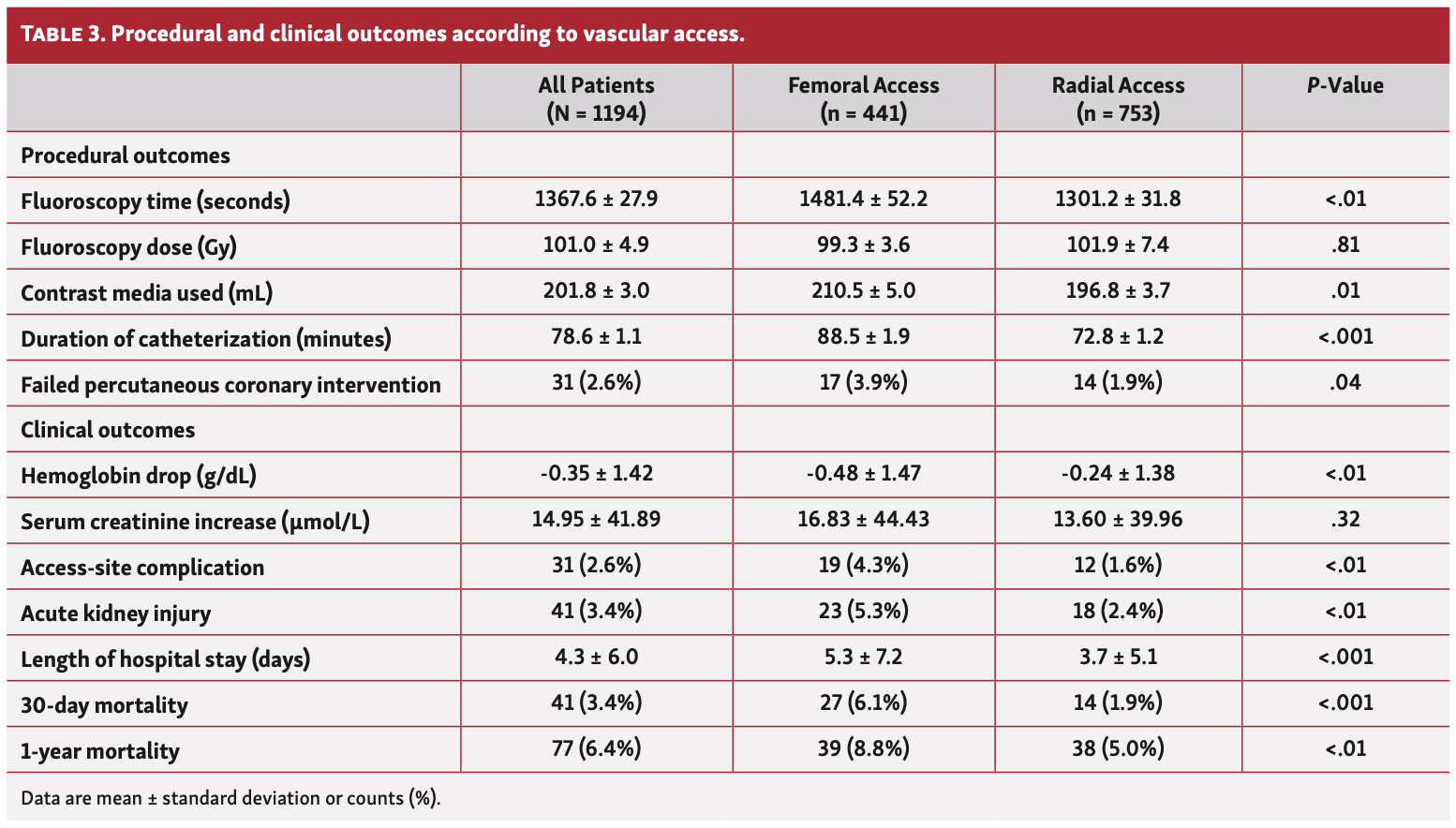
Overall, there were 77 deaths (6.4%) within the first year after coronary catheterization. Death occurred in 39 patients with a femoral access vs 38 patients with a radial access (Kaplan-Meier estimates of 1-year mortality, 10.8% and 6.3%, respectively; HR, 2.0; 95% CI, 1.28-3.13; P<.01). Within 30 days after coronary catheterization, 27 deaths occurred among patients treated via the femoral artery and 14 deaths occurred among patients treated via the radial artery (Kaplan-Meier estimates of 30-day mortality, 6.8% and 2.0%, respectively; HR, 3.52; 95% CI, 1.84-6.70; P<.001). Time-to-event curves obtained by Kaplan-Meier estimates for 30-day and 1-year mortality are shown in Figure 1 and Figure 2, respectively. Even after adjustment for STEMI and CPR in the multivariate Cox proportional hazards model, femoral access remained strongly associated with an increased risk for mortality (HR, 1.86; 95% CI, 1.18-2.93; P<.01).

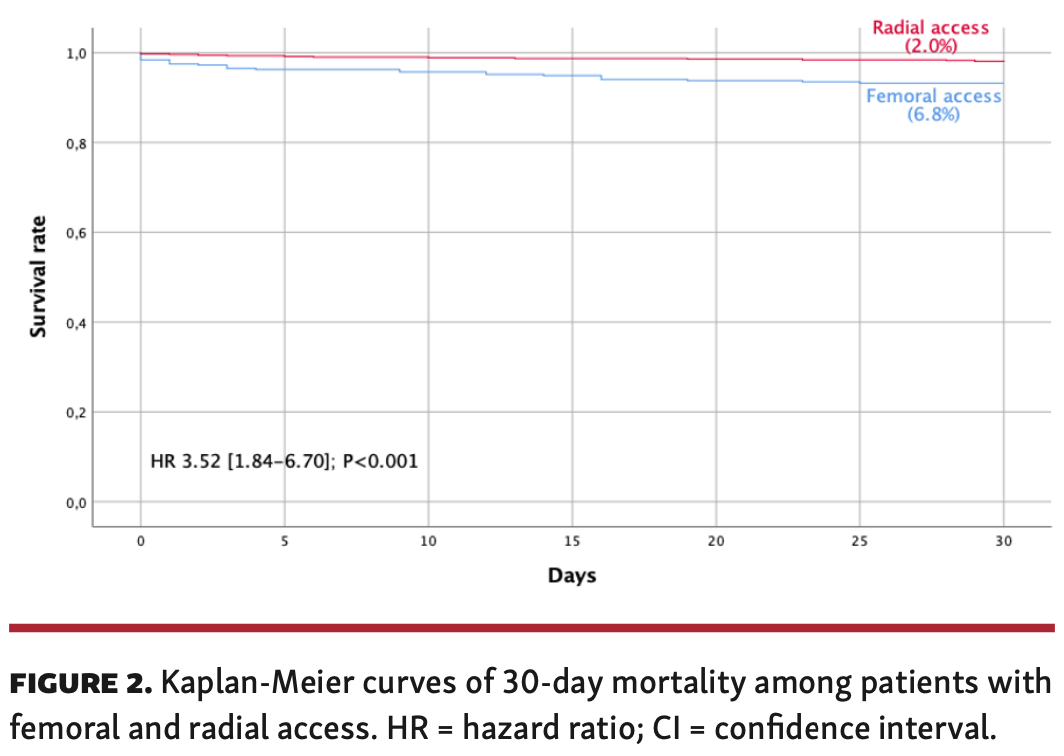
Subgroup of patients with access-site crossover. Out of 1194 patients included in the present study, access-site crossover during coronary catheterization occurred in 128 patients (10.7%). Of these, 116 (90.6%) were switched from a radial to a femoral approach. Figure 3 offers detailed description of access-site crossover. Reasons for crossover included tortuosity of the radial artery (12.1%), radial artery spasm (7.8%), puncture failure (11.2%), severe vessel calcification (2.6%), and anatomic variants or issues with subclavian/ascending aorta (8.6%), among others. Baseline characteristics and procedural data of the access-site crossover subgroup (from radial to femoral approach) vs those who underwent successful radial access are shown in Table 4, Part 1 and Table 4, Part 2.
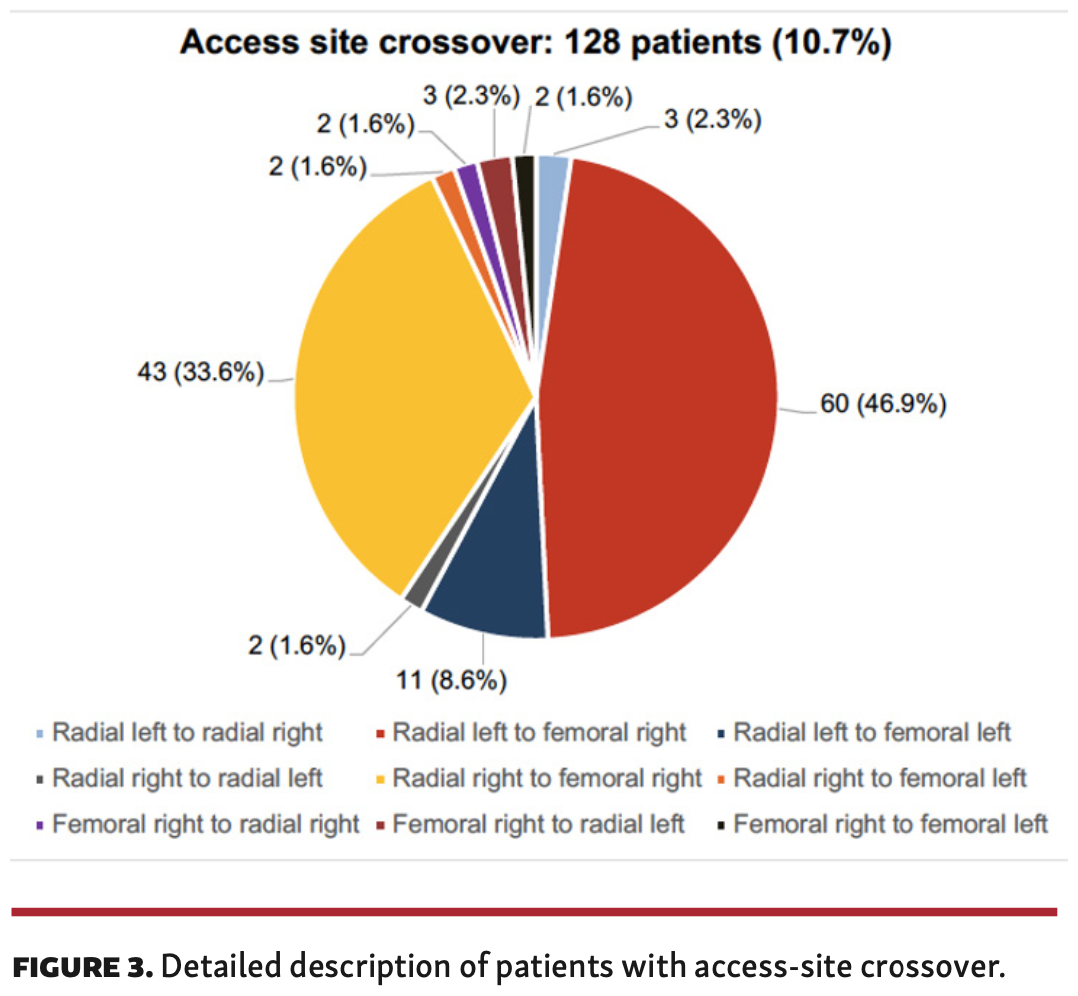

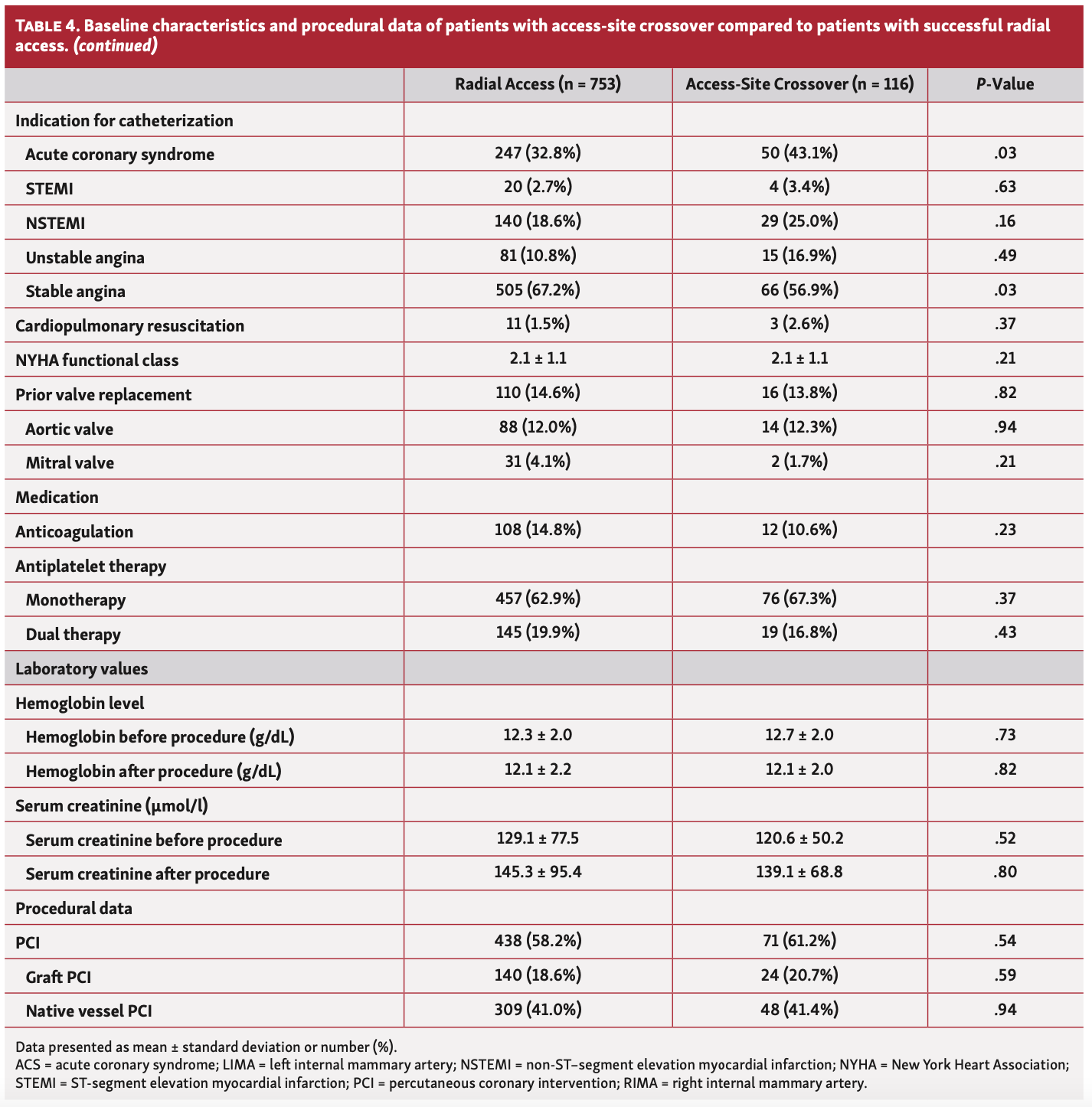
Patients undergoing access-site crossover had smaller body size (169 ± 8.7 cm vs 171.2 ± 10.2 cm; P=.03) and were more likely to present with ACS (50 patients [43.1%] vs 247 patients [32.8%]; P=.03) compared with those treated via the radial artery. All other variables were similarly distributed between the 2 groups.
Univariate and multivariate logistic regression analyses were used to identify independent predictors of access-site crossover from a radial to a femoral approach. After adjustment, small body size (OR, 2.21; P<.001) and ACS (OR, 1.54; P=.04) were the only variables independently associated with an elevated risk of access-site crossover (Table 5).

Not surprisingly, access-site crossover was associated with a significantly longer procedural time (102.9 ± 43.6 minutes vs 72.8 ± 1.2 minutes; P<.001) and fluoroscopy time (1732.7 ± 1021.2 seconds vs 1301.2 ± 31.8 seconds; P<.001) compared with an initially successful radial access. All other procedural and clinical outcomes did not differ significantly between the 2 groups and are displayed in Table 6. Within the first year after coronary catheterization, 6 patients with access-site crossover died compared with 38 deaths in the group with successful radial access (Kaplan-Meier estimates of 1-year mortality, 6.4% vs 6.3% respectively; HR, 1.06; 95% CI, 0.45-2.50; P=.90). Within the first 30 days, 4 deaths occurred in the access-site crossover population compared with 14 deaths in the radial cohort (Kaplan-Meier estimates of 30-day mortality, 3.9% and 2.0%, respectively; HR, 1.89; 95% CI, 0.62-5.75; P=.26). Time-to-event curves obtained by Kaplan-Meier estimates for 30-day and 1-year mortality are shown in Figure 4 and Figure 5, respectively.
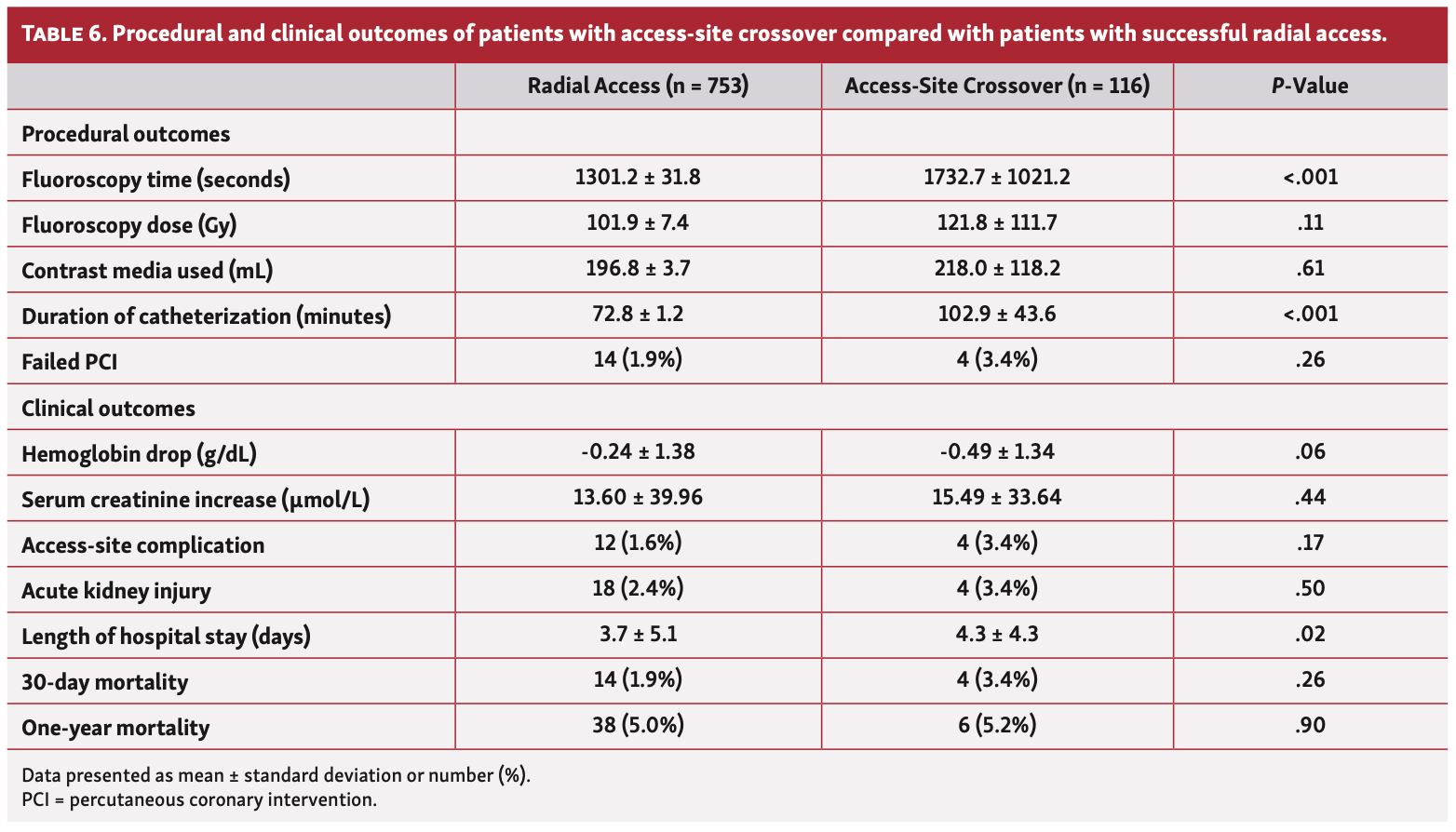

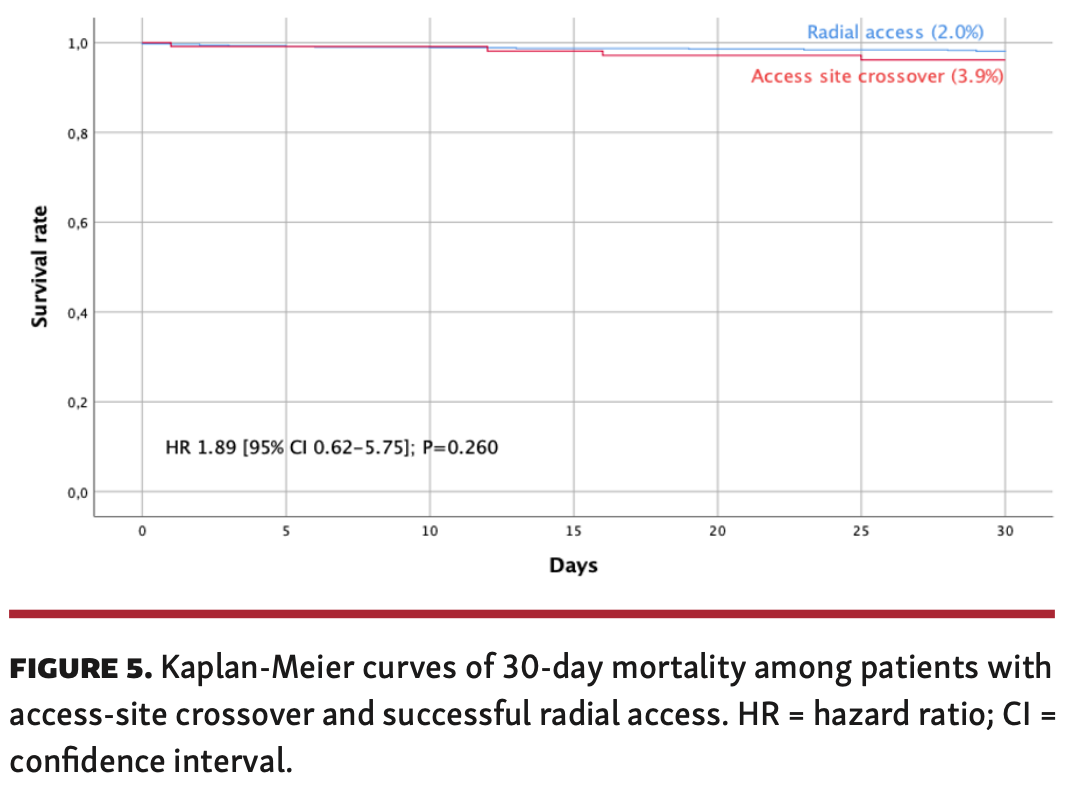
Discussion
The main findings of the present study may be summarized as follows. In patients with a history of CABG, radial access is feasible, safe, and effective for coronary angiography and intervention. Short stature, peripheral artery disease, STEMI, CPR, as well as coexisting LIMA and RIMA grafts were independently associated with femoral access-site choice. Transradial access was superior with respect to short- and long-term outcomes up to 1 year after coronary catheterization compared with the transfemoral route. Radial access was also associated with a lower volume of contrast given and shorter procedure and fluoroscopy times. The rate of access-site crossover was 10.7%. Independent predictors of access-site crossover were short stature and ACS.
Nowadays, radial artery access is the preferred vascular approach for coronary angiography and PCI in various clinical settings and has risen steadily year by year.1,2,7 Although it may be technically more challenging, transradial catheterization has proven to be superior over transfemoral catheterization, with many possible advantages.10 It is noteworthy that despite the major changes in overall practice, several subgroups of PCI procedures, such as coronary artery bypass grafting (CABG)-PCI, are still frequently performed via the femoral artery.7,11 Paradoxically, patients with previous CABG are often burdened with high cardiovascular comorbidity, as can be seen in our study population, and possess an increased risk for adverse events compared with the general PCI population.7 Consequently, this patient cohort may particularly benefit from the transradial access route. Over the past decade, there has been a significant increase in the usage of radial access, even for CABG-PCI.7 However, there is still a wide range in radial access use for CABG-PCI, which is mainly driven by operator volume, experience, comfort, and personal choice.7,12 Interestingly, even in our high-volume center in which the radial access is the preferred vascular approach for all patient subgroups, including CABG patients, the femoral approach was chosen in 36.9% of all procedures. Nevertheless, we observed a decrease in femoral artery utilization from 55.2% in 2010 to a minimum of 28.2% in 2016 in this patient cohort. Since 2012—2 years after setting the radial approach as the standard vascular access site—significantly more coronary catheterizations have been performed annually via the radial artery compared with the femoral artery in our university hospital. Furthermore, we were able to show that it was an independent association for radial access to be utilized for cardiac catheterization from the year 2012 onward (OR, 1.71; P<.001). Consequently, entrenched practice is potentially leading to improved procedural and clinical outcomes as well as to fewer adverse events.
Several baseline and procedural factors that are associated with access-site choice for PCI-CABG are described in the literature. We identified short stature, peripheral artery disease, STEMI, cardiopulmonary resuscitation as well as coexisting LIMA and RIMA grafts as independent predictors of femoral access site choice in our CABG population. Our study results are in line with the largest trial by Kinnaird et al, which showed female sex, ACS, chronic total occlusion, and lower operator volume as correlates for the femoral approach.7 Clinical factors, such as small body size and peripheral artery disease, led to difficulties in adequate arterial cannulation due to smaller artery caliber or severe calcification. Other studies described female sex as an independent predictor for femoral access,12 which lastly confirms our results. However, female sex was statistically dependent upon both body size and weight; therefore, we did not include it in the final analysis. The association between femoral artery use and presentation with ACS or CPR may be explained by the lack of information on the previous CABG as well as the need to reopen the target lesion as fast as possible in the acute setting.7 The femoral route provides enough space and great back-ups for catheterization of the grafts and therefore facilitates coronary imaging and intervention,13 at least from the perspective of the interventionalist.
Regarding bypass conduits, LIMA grafts were associated with a radial approach, whereas the existence of both LIMA and RIMA grafts were correlated with a femoral access site choice. In our CABG cohort, two-thirds of patients with LIMA grafts underwent coronary catheterization via radial access and 81.7% of these were realized through the left radial artery. For bypass angiography, left radial artery access has been recommended as a default access site, as the majority of these patients have an in situ LIMA bypass graft. LIMA cannulation from the right radial artery is also possible, but technically very demanding and is mostly only considered in circumstances when the left radial artery is unsuitable, has been explanted, or the RIMA has been used for bypass. Major challenges are to navigate through the right subclavian and aortic tortuosity, to cannulate the left subclavian artery and to park the guidewire into the left arm, as the wire has a tendency to prolapse into the ascending aorta. Nevertheless, as the data regarding the advantages of the radial approach over the femoral approach continue to accumulate, usage of the right radial access site may also increase during CABG procedures.
If necessary, angiographic visualization of the LIMA graft using the right radial artery can be performed using the following steps:
(1) Cannulation of the left subclavian artery: a Tiger catheter or a catheter with a similar bend should be advanced into the descending thoracic aorta. When the superior wall is faced with the tip of the arch, the catheter will snap and engage the left subclavian artery.
(2) A 0.035˝ hydrophilic-coated guidewire with an angled tip is carefully advanced deep into the axillary/ brachial artery. Now, the wire can be left in brachial artery, while the Tiger catheter is removed and replaced by an internal mammary artery (IMA) catheter. Alternatively, a Judkins right catheter can be used. Once the catheter is advanced deep in the subclavian artery, the wire can now be withdrawn, and the catheter will—by careful retraction and slight torque (and perhaps slight administration of contrast)—engage the ostium of the LIMA.
(3) If the advancement of a guiding catheter is very difficult, we do not recommend making any attempt to stabilize the wire to avoid the increased risk of arterial dissection. At least now (if not before), it is time to switch to the left radial access or femoral access.
Some recent trials have found promising trends in mortality reduction in various clinical settings by using the transradial approach.14-16 Furthermore, the radial access is particularly associated with a decrease in major adverse cardiac event (MACE) rate, major bleeding and vascular complications compared to the femoral approach.3-6,17,18 As shown in the present trial, it appears that these superiorities do in fact extend to PCI in high-risk patients with previous CABG, a subpopulation under-represented in a majority of studies comparing the 2 vascular access sites.5,9 In our analysis with 1194 CABG patients, transradial access was significantly associated with lower rates of procedural complications and mortality up to 1 year after coronary catheterization, even after adjustment for confounders. Moreover, the radial access site was significantly associated with shorter procedure and fluoroscopy times as well as lower amounts of contrast media used compared with the femoral access. Finally, we observed a reduced postprocedural hospital stay by almost 2 days among patients with transradial approach, which underscores the advantages of radial access, especially in terms of economic aspects.19
One concern about the transradial approach is the higher crossover rate of vascular access. The reported 10.7% rate of access-site crossover in this study compares with those reported by other centers, which ranges between 3.8% and 17.0%.3, 20-22 Leading causes for conversion to the femoral artery were radial artery spasm and artery tortuosity, resulting in difficulty in inserting the catheter. The rather high crossover rate may be accounted for by high cardiovascular risk profile, severe forms of atherosclerosis and CAD, as well as complex procedures with greater difficulties in engaging a bypass graft in patients with previous CABG surgery. A large, retrospective study by Dehgani et al revealed prior CABG as an independent predictor of radial access-site failure.23 In addition, some further correlates of an unsuccessful radial approach were already reported in the literature, including advanced age, short stature, female gender, higher body mass index, and presence of hypertension.23,24 In the present study, small body size and presentation with ACS were the only identifiable characteristics to have a significant influence on the rate of access-site crossover. Short stature often accompanies smaller radial arteries and increased subclavian tortuosity.25 The association between ACS presentation and higher crossover rates may be explained, as mentioned above, by the need to reopen the target lesion as fast as possible as well as by the lack of information on the previous CABG in the acute setting.7 Access-site crossover can potentially be problematic as it may increase procedure duration, radiation exposure, and risk of vascular complications related to multiple sites of access.24 Not surprisingly, in our study, access-site crossover came along with increased procedure and radiation times. However, all other procedural and clinical outcomes were similar between patients with initial successful radial approach and patients with access-site crossover. In particular, we observed similar rates of short- and long-term mortality as well as access-site complications despite multiple vessel punctures.
In case of radial access-site failure, we mostly observed crossover to the femoral approach in our study population. Only very few patients got bilateral radial access as a crossover, reflecting daily clinical practice. As compared with femoral access, left radial approach especially presents additional technical difficulties, mainly represented by the increased discomfort for the operator in long-lasting and challenging procedures. Nevertheless, our results suggest that the radial access should be considered as the preferred vascular approach even in high-risk populations such as CABG patients, because the benefits seem to outweigh the disadvantages. Furthermore, radial access-site failure and subsequent crossover to the femoral artery were not associated with significantly worse outcomes. In this regard, a bilateral radial access also seems reasonable and should be considered in case of radial access-site failure. As short stature represents one of the essential risk factors for radial access-site failure, specifically designed radial guide catheters might improve guide catheter performance in these patients.23
Study limitations. The results of our study have to be interpreted with caution. First, our analysis is a single-center, retrospective, observational study, with the bias ascribed to this type of design. Second, the ultimate choice of access remained with each examiner. It should be noted again that radial access is the preferred primary access at our center and that all of the interventionists had great expertise in the use of the transradial approach. This factor was also the cause of the sample size discrepancy between the transfemoral and transradial groups. Third, we enrolled a heterogeneous population of patients with CABG, including diagnostic and PCI procedures as well as different anatomic subsets. However, as in the overall study, a subgroup analysis that contained only those patients undergoing PCI showed similar results. Fourth, the worse outcomes of patients with femoral access can be at least partly explained by a higher proportion of patients with ACS and CPR. However, even after adjustment for confounders, femoral access was still independently associated with increased risk for mortality. Lastly, analysis based on graft type, graft number, or any combination of these was not done in this study because such groupings would lead to a smaller sample size and we would therefore not be able to exclude other confounding factors.
Conclusion
In high-volume centers with significant experience using the radial approach, coronary catheterization through the radial access seems to be favorable even in complex patients with a history of CABG. Entrenched practice of radial access is potentially leading to decreased utilization of the transfemoral approach and consequently evidence of improved procedural and clinical outcomes in this high-risk population. However, even though radial access was set as our standard vascular approach, femoral access was chosen in almost one-third of all patients undergoing coronary catheterization. Independent predictors for femoral access were short stature, concomitant peripheral artery disease, acute settings like STEMI and CPR, as well as coexisting LIMA and RIMA grafts. Access-site crossover seems not to be associated with a significantly worse outcome.
Affiliations and Disclosures
From the 1Department of Cardiology, Angiology, Pneumology and Internal Intensive Care, University of Ulm, Ulm, Germany. ORCID: 0000-0001-9708-0702
Disclosure: The authors have completed and returned the ICMJE Form for Disclosure of Potential Conflicts of Interest. The authors report no conflicts of interest regarding the content herein.
Manuscript accepted April 27, 2021.
Address for correspondence: PD Dr Sinisa Markovic, University Hospital Ulm, Department of Cardiology, Angiology and Pneumology, Albert-Einstein-Allee 23, 89081 Ulm, Germany. Email: sinisa.markovic@uniklinik-ulm.de
Related Articles
- Pseudoaneurysm Formation After Cardiac Catheterization Using the Distal Transradial Approach
- Orbital Atherectomy Via Transradial Access: A Multicenter Propensity-Matched Analysis
- Arterial Anomalies of the Upper Limb and Their Influence on Transradial Coronary Procedures
- TIger II vs JUdkins Catheters for Transradial Coronary Angiography (TIJUCA Study): A Randomized Controlled Trial of Radiation Exposure
- Bilateral Distal Transradial Access for Ostial Left Anterior Descending Chronic Total Occlusion Recanalization
References
1. Bradley SM, Rao SV, Curtis JP, et al. Change in hospital-level use of transradial percutaneous coronary intervention and periprocedural outcomes: insights from the national cardiovascular data registry. Circ Cardiovasc Qual Outcomes. 2014;7(4):550-559. doi: 10.1161/CIRCOUTCOMES.114.001020
2. Feldman DN, Swaminathan RV, Kaltenbach LA, et al. Adoption of radial access and comparison of outcomes to femoral access in percutaneous coronary intervention: an updated report from the national cardiovascular data registry (2007-2012). Circulation. 2013;127(23):2295-2306. doi: 10.1161/CIRCULATIONAHA.112.000536
3. Agostoni P, Biondi-Zoccai GG, de Benedictis ML, et al. Radial versus femoral approach for percutaneous coronary diagnostic and interventional procedures; Systematic overview and meta-analysis of randomized trials. J Am Coll Cardiol. 2004;44(2):349-356. doi: 10.1016/j.jacc.2004.04.034
4. Hamon M, Mehta S, Steg PG, et al. Impact of transradial and transfemoral coronary interventions on bleeding and net adverse clinical events in acute coronary syndromes. EuroIntervention. 2011;7(1):91-97. doi: 10.4244/EIJV7I1A16
5. Jolly SS, Yusuf S, Cairns J, et al. Radial versus femoral access for coronary angiography and intervention in patients with acute coronary syndromes (RIVAL): a randomised, parallel group, multicentre trial. Lancet. 2011;377(9775):1409-1420. Epub 2011 Apr 4. doi: 10.1016/S0140-6736(11)60404-2
6. Rao SV, Ou FS, Wang TY, et al. Trends in the prevalence and outcomes of radial and femoral approaches to percutaneous coronary intervention: a report from the National Cardiovascular Data Registry. JACC Cardiovasc Intervent. 2008;1(4):379-386. doi: 10.1016/j.jcin.2008.05.007
7. Kinnaird T, Anderson R, Gallagher S, et al. Vascular access site and outcomes in 58,870 patients undergoing percutaneous coronary intervention with a previous history of coronary bypass surgery: results from the British Cardiovascular Interventions Society National Database. JACC Cardiovasc Intervent. 2018;11(5):482-492. doi: 10.1016/j.jcin.2017.12.020
8. Rigattieri S, Sciahbasi A, Brilakis ES, et al. Meta-analysis of radial versus femoral artery approach for coronary procedures in patients with previous coronary artery bypass grafting. Am J Cardiol. 2016;117(8):1248-1255. Epub 2016 Jan 28. doi: 10.1016/j.amjcard.2016.01.016
9. Romagnoli E, Biondi-Zoccai G, Sciahbasi A, et al. Radial versus femoral randomized investigation in ST-segment elevation acute coronary syndrome: the RIFLE-STEACS (Radial Versus Femoral Randomized Investigation in ST-Elevation Acute Coronary Syndrome) study. J Am Coll Cardiol. 2012;60(24):2481-2489. Epub 2012 Aug 1. doi: 10.1016/j.jacc.2012.06.017
10. Hirzallah H, Amro A, Kusmic D, et al. Comparison of transradial and transfemoral approaches for coronary angiography and percutaneous intervention in patients with coronary bypass grafts. Cardiovasc Revasc Med. 2020;21(1):2-5. Epub 2019 Mar 12. doi: 10.1016/j.carrev.2019.03.002
11. Kinnaird T, Anderson R, Ossei-Gerning N, et al. Legacy effect of coronary perforation complicating percutaneous coronary intervention for chronic total occlusive disease: an analysis of 26 807 cases From the British Cardiovascular Intervention Society Database. Circ Cardiovasc Interv. 2017;10(5):e004642. doi: 10.1161/CIRCINTERVENTIONS.116.004642
12. Carvalho MS, Cale R, Goncalves Pde A, et al. Predictors of conversion from radial into femoral access in cardiac catheterization. Arq Bras Cardiol. 2015;104(5):401-408. Epub 2015 Mar 17. doi: 10.5935/abc.20150017
13. He PY, Yang YJ, Qiao SB, et al. A comparison of the transradial and transfemoral approaches for the angiography and intervention in patients with a history of coronary artery bypass surgery: in-hospital and 1-year follow-up results. Chinese Med J. 2015;128(6):762-767. doi: 10.4103/0366-6999.152488
14. Hetherington SL, Adam Z, Morley R, et al. Primary percutaneous coronary intervention for acute ST-segment elevation myocardial infarction: changing patterns of vascular access, radial versus femoral artery. Heart. 2009;95(19):1612-1618. Epub 2009 Jul 12. doi: 10.1136/hrt.2009.170233
15. Pristipino C, Trani C, Nazzaro MS, et al. Major improvement of percutaneous cardiovascular procedure outcomes with radial artery catheterisation: results from the PREVAIL study. Heart. 2009;95(6):476-482. Epub 2008 Nov 26. doi: 10.1136/hrt.2008.150714
16. Chase AJ, Fretz EB, Warburton WP, et al. Association of the arterial access site at angioplasty with transfusion and mortality: the M.O.R.T.A.L study (Mortality benefit Of Reduced Transfusion after percutaneous coronary intervention via the Arm or Leg). Heart. 2008;94(8):1019-1025. Epub 2008 Mar 10. doi: 10.1136/hrt.2007.136390
17. Valgimigli M, Gagnor A, Calabro P, et al. Radial versus femoral access in patients with acute coronary syndromes undergoing invasive management: a randomised multicentre trial. Lancet. 2015;385(9986):2465-2476. Epub 2015 Mar 16. doi: 10.1016/S0140-6736(15)60292-6
18. Jolly SS, Amlani S, Hamon M, Yusuf S, Mehta SR. Radial versus femoral access for coronary angiography or intervention and the impact on major bleeding and ischemic events: a systematic review and meta-analysis of randomized trials. Am Heart J. 2009;157(1):132-140. Epub 2008 Nov 1. doi: 10.1016/j.ahj.2008.08.023
19. Amin AP, House JA, Safley DM, et al. Costs of transradial percutaneous coronary intervention. JACC Cardiovasc intervent. 2013;6(8):827-834. Epub 2013 Jul 17. doi: 10.1016/j.jcin.2013.04.014
20. Mann T, Cubeddu G, Bowen J, et al. Stenting in acute coronary syndromes: a comparison of radial versus femoral access sites. J Am Coll Cardiol. 1998;32(3):572-576. doi: 10.1016/s0735-1097(98)00288-5
21. Louvard Y, Lefevre T, Allain A and Morice M. Coronary angiography through the radial or the femoral approach: the CARAFE study. Catheter Cardiovasc Interv. 2001;52(2):181-187. doi: 10.1002/1522-726x(200102)52:2<181::aid-ccd1044>3.0.co;2-g
22. Bertrand OF, Belisle P, Joyal D, et al. Comparison of transradial and femoral approaches for percutaneous coronary interventions: a systematic review and hierarchical Bayesian meta-analysis. Am Heart J. 2012;163(4):632-648. doi: 10.1016/j.ahj.2012.01.015
23. Dehghani P, Mohammad A, Bajaj R, et al. Mechanism and predictors of failed transradial approach for percutaneous coronary interventions. JACC Cardiovasc Interv. 2009;2(11):1057-1064. doi: 10.1016/j.jcin.2009.07.014
24. Le J, Bangalore S, Guo Y, et al. Predictors of access site crossover in patients who underwent transradial coronary angiography. Am J Cardiol. 2015;116(3):379-383. Epub 2015 May 8. doi: 10.1016/j.amjcard.2015.04.051
25. Cha KS, Kim MH, Kim HJ. Prevalence and clinical predictors of severe tortuosity of right subclavian artery in patients undergoing transradial coronary angiography. Am J Cardiol. 2003;92(10):1220-1222. doi: 10.1016/j.amjcard.2003.07.038


















